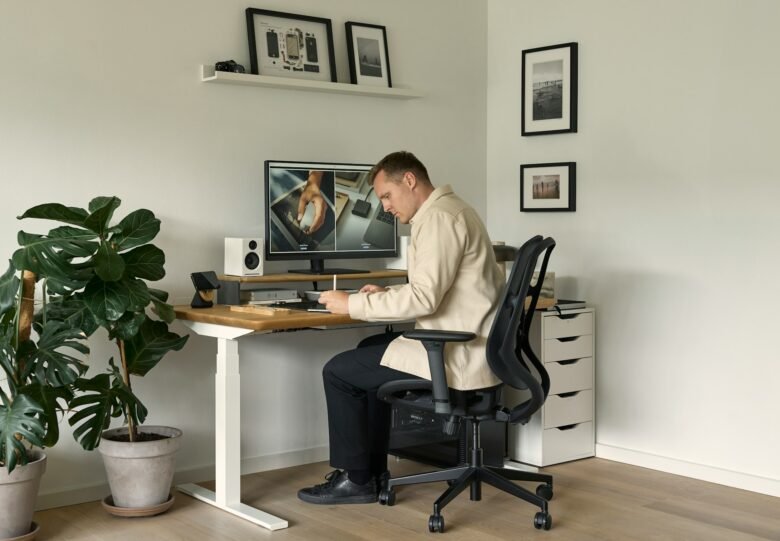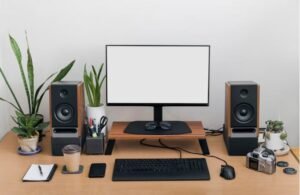Standing Desk vs. Traditional Desk
Is your desk helping or hurting you? If you’ve ever stood up after a long work session feeling stiff, sore, or tired, your workstation setup might be to blame. That’s why today’s question Standing Desk vs. Traditional Desk: Is the Upgrade Worth It? is more important than ever.
As a tech journalist and full-time remote worker, I’ve spent years switching between sit-only desks and standing desk setups. I’ve tested dozens of models and talked to physical therapists, chiropractors, and productivity coaches. This article is a deep-dive comparison of the two, focusing on long-term productivity, posture, and back pain relief.
What’s the Difference Between Standing and Traditional Desks?
Traditional Desk
- Fixed height, usually 28–30 inches
- Designed for seated work only
- May come with drawers, shelves, or keyboard trays
Standing Desk
- Height-adjustable (manual or electric)
- Can switch between standing and sitting
- Often minimalist in design, built for ergonomics
Key Point: Standing desks offer flexibility—but does that translate into better outcomes?
Quick Comparison Table: Standing Desk vs Traditional Desk
| Feature | Standing Desk | Traditional Desk |
|---|---|---|
| Adjustability | Sit-stand height range | Fixed height only |
| Ergonomics | Customizable for posture | Depends on chair |
| Cost | $200 – $1,000+ | $100 – $600 |
| Back Pain Relief | High (with movement) | Low (if sitting long hours) |
| Productivity Impact | Positive if used correctly | Neutral or negative |
| Setup Space | Minimal, cable management needed | Often bulkier |
Long-Term Productivity: Which Desk Wins?
Focus and Flow
Standing Desks: Switching between positions can reduce fatigue and improve mental clarity.
Traditional Desks: Longer sitting hours lead to more breaks and distraction.
Real-World User Feedback:
“I get drowsy in the afternoons. Since I started standing for two hours a day, my energy levels are more stable.” – Melissa, content strategist
“When I stand during client calls, I naturally speak with more confidence and focus.” – Trevor, project manager
Verdict: Standing desks increase sustained energy and focus for many users.
Posture and Back Pain: The Real Ergonomic Battle
🔹 Traditional Desk (and Chair) Challenges:
- Slouching due to poor lumbar support
- Hip and shoulder compression
- Increased spinal pressure
🔹 Standing Desk Benefits:
- Improved spine alignment
- More movement = less stiffness
- Encourages better posture habits
Expert Insight:
“We’re not designed to sit still for 8 hours. Alternating between sitting and standing encourages blood flow and keeps joints mobile.” — Dr. Janice Hall, PT, DPT
But Beware: Standing all day isn’t ideal either.
Use a sit-stand ratio of 1:1 or 2:1, and consider anti-fatigue mats and proper footwear.
Which Desk Is Right for Your Body Type?
| Body Type | Best Desk Type | Why |
| Petite (<5’5”) | Standing desk w/ low range | Adjusts below 24″ for elbow height |
| Tall (6’2”+) | Electric standing desk | Extends beyond 48–50” height |
| Heavyset (250+ lbs) | Reinforced standing desk | Requires weight rating 300–400 lbs |
| Mobility concerns | Traditional desk w/ ergonomic chair | Easier to manage daily |
Cost Breakdown: Value Over Time
| Expense Factor | Standing Desk | Traditional Desk |
| Initial Cost | Higher (~$300–$1,200) | Lower (~$100–$500) |
| Health Impact | Reduced pain & fatigue | More risk of injury |
| Replacement Frequency | Lasts 5–10+ years | May replace chair more often |
Think of a standing desk as an investment in your spine—not just your office.
Top Standing Desk Recommendations (2025)
| Brand & Model | Height Range | Features | Price |
| Uplift V2 | 22.6–48.7″ | Dual motors, stable frame | $599+ |
| FlexiSpot E7 Pro | 22.8–48.4″ | 355 lb capacity, quiet lift | $529+ |
| Vari Electric Desk | 25–50.5″ | Easy install, sleek design | $595 |
| Autonomous SmartDesk | 26–52″ | High range, app-controlled | $499 |
Key Takeaways Table
| Use Case | Winner | Why |
| All-day sitting | Traditional desk | More comfort when paired with chair |
| Reducing back pain | Standing desk | Encourages movement |
| Increasing energy/focus | Standing desk | Movement improves alertness |
| Budget setup for light work | Traditional desk | Lower cost and simpler needs |
| Long-term ergonomic investment | Standing desk | Improves health & posture |
Is the Standing Desk Upgrade Worth It?
Yes, for most people—if you use it properly. Standing desks don’t magically solve posture or productivity problems, but they give you the flexibility to move more, sit less, and stay aligned.
If you work long hours, deal with lower back pain, or feel sluggish in the afternoon, a standing desk can be a game-changer.
That said, pairing it with a supportive chair, a mat, and a structured routine will give you the best results.
Do you use a standing desk or still sitting full-time? Share your experience below!
Subscribe for more science-backed productivity and gear reviews.
Need help choosing a desk? Check out our “Best Standing Desks by Body Type” guide next.
Move better. Sit smarter. Work healthier.




